

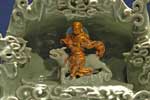
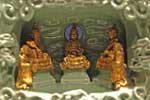
Ming Dynasty, Yongle peeriod, dated CE 1406. From Longquan kilns, Zhejiang province, SE China. H.: 49.5 cm. Moulded, incised, gilded and glazed porcelain.
OA 1929.1-14.1
Learn more.



Ming Dynasty, Yongle period, 1403-1424. Porcelain, modeled on Iranian metalwork but with Chinese details.
OA 1963.12-19.1
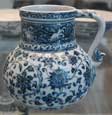
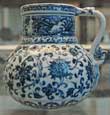
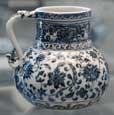

Ming Dynasty, Yongle period, 1403-1424. Jingdezhen porcelain, Jiangxi Province, S. China. H.: 14 cm. Probably originally had a lid.
The shape shows the influence of Middle Eastern metalwork. Tankards with this shape were very popular in Timurid Iran.
OA 1950.4-3.1
Read more.
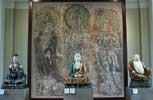
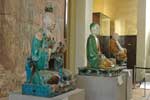
(1) Wall painting of three bodhisattvas is from Qingliang Temple, Xingtang xian, Hebei. Inscription of 1485 indicates it was painted by a monk from Mutai shan in 1424 and subsequent decades. OA 1927.5-18.8
(2) Two Ming-period statues flank one of a luohan made in Liao Dynasty. For details of the center and right ones, click on the inventory numbers: OA 1930.7-19.62; OA 1913.11-21.1; OA 1937.1-13.1.
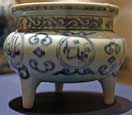
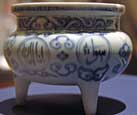
Ming dynasty, Zhengde period, 1506-1521 CE. Jingdezhen porcelain.
The six roundels with Arabic inscriptions read: "I am the compassionate one"; "Ask for me"; "You will find me"; "Pray for me"; "Do not contemplate [any other]"; "except for me."
OA 1973.7-26.367
This was a period when Muslim administrators were very influential at the Ming court; at least one Arab source indicates the Emperor in fact had converted to Islam.
Read more.

Ming dynasty, Zhengde period, 1506-1521 CE. Jingdezhen porcelain.
Arabic inscription reads: "O God, make safe his country" "and protect his progeny."
OA F.265

Ming dynasty, Zhengde period, 1506-1521 CE. Jingdezhen porcelain.
Arabic inscription reads: "Blindness does not benefit mankind; the fool finds no contentment; wisdom causes weakness to flee."
OA 1973.7-26.364

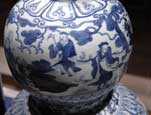

Ming Dynasty, Jiajing period, 1522-1566 CE. Jingdezhen porcelain (note: only the middle photo represents the color properly).
OA F 1672


Ming Dynasty, first year of Wanli reign, 1573 CE. Donation by three generations of the Xia family.
Moulded, incised, fahua glazed stoneware.
OA 1988.7-28.1


Ming Dynasty, late 16th-early 17th c. CE. Jingdezhen porcelain, along with example (in foreground) of an Iranian, early 17th-century earthenware bottle with landscape design, modeled on late Ming porcelain.
OA 1957.12-16.4; 1896.6-26.2